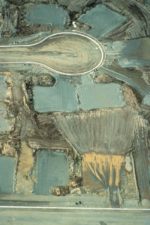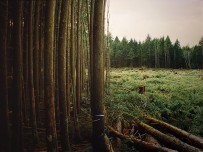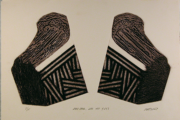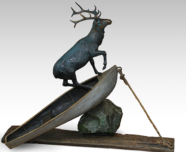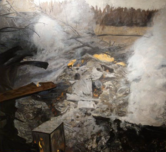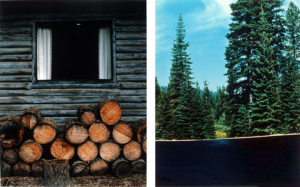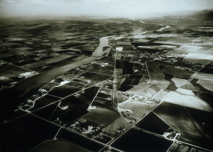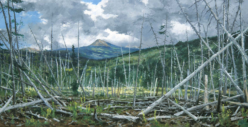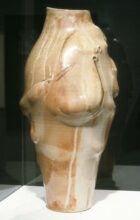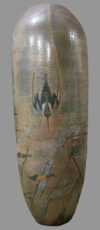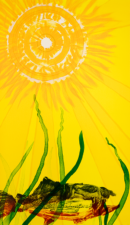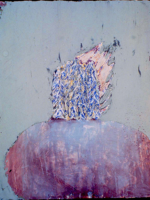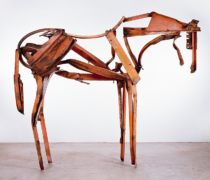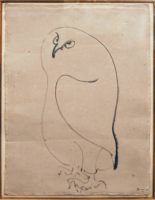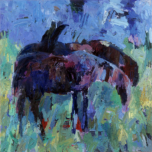Myths, Fables, and Fortunes: Our Place within the Landscape
Accessible Guide
Introduction
Audio Recording
Myths, Fables, and Fortunes: Our Place within the Landscape
Myths, Fables, and Fortunes is a journey of discovery focused on the natural environment of the Northwest. Drawn from the Museum’s Permanent Collection and spanning over six decades, the exhibition highlights our shifting perspectives and connection with the land during a period of dramatic change and development.
Our relationship with the land conveys a compelling narrative of who we are as individuals and as a culture. With nature as the setting– its forests, plants, rivers, and animals – these artists share critical stories and lessons that both inform and shape the destiny of future generations. Whether conveying the iconic beauty and grandeur of the wilderness, or probing the complex environmental, social, and economic issues entwined with our shared ecology, the works in Myths, Fables, and Fortunes reveal our ever-evolving connection to the natural world.
Organized by the Boise Art Museum
American Sign Language Interpretation 
Section Topic: Conservation and the Artist Explorer
Audio Recording
Myths, Fables, and Fortunes features pristine views of the land, as well as more sobering imagery documenting the detrimental impact of human development on our environment. Today, many artists are committed to an ongoing exploration of the power and attraction of the natural landscape. For these artists, physical observation and experience are fundamental to their creative process.
Since the beginning of human-generated imagery, artists have depicted the ecosystems and wildlife of the Northwest. As nature has become more accessible, it has also undergone significant human impact and habitat loss. Artists, especially photographers, have become important conservation activists as they visually advocate for protecting the land’s fragile ecology to ensure it for future generations.
American Sign Language Interpretation 
Tony Foster, Mile 162.5 (from the Whole Salmon project), 2003
Audio Recording
Tony Foster
(b. 1946, Lincolnshire, England)
Mile 162.5 (from the Whole Salmon project), 2003
Pencil, watercolor on paper, discarded epidermis, Lewis and Clark medal, mapBoise Art Museum Permanent Collection
Since 1982, British artist Tony Foster has completed a series of “journeys”—painting projects that have centered on modern wilderness expeditions similar to those completed by 19th-century explorers such as Thomas Moran (1837-1926) and Albert Bierstadt (1830-1902). For each journey, the artist-explorer creates lush watercolor diaries, some of which may take as long as a decade to complete, over the course of several journeys. Foster’s travels have ranged from mountains and canyons to rainforests, coral reefs, and rivers. Often, the artist endures harsh weather and challenging travel conditions to document remote sites in his paintings.
In 2002, Foster was commissioned by Idaho’s Sun Valley Center for the Arts to conduct a new journey as part of The Whole Salmon project. For his project, Foster produced a chronological series of watercolors that depicted his experience traveling down Idaho’s 406-mile-long Salmon River. Mile 162.5 is one of 31 artworks from Foster’s month-long journey, a vibrant light-filled landscape with a meandering river that captures the beauty, diversity, and history of the Salmon River.
Laura McPhee, Understory FlareUps, Fourth of July Creek, Valley Road Wildfire, Custer County, Idaho, 2005
Audio Recording
Laura McPhee
(b. 1958, New York, NY)
Understory FlareUps, Fourth of July Creek, Valley Road Wildfire, Custer County, Idaho, 2005
Chromogenic print
Boise Art Museum Permanent Collection
Collectors Forum Purchase, 2007
Laura McPhee seeks meaning in the history and language of place through her large-scale color photographs that juxtapose historical respect for the American landscape with the unforgiving reality of our contemporary environment. Moving between past and present, she combines historical photographic methods, such as an 8 x 10 view camera with digital imaging, capturing our evolving perceptions of the landscape in her beautiful, yet disquieting imagery.
Inspired by the 19th-century American landscape conventions, which often presented romanticized views of the American West, McPhee questions the promises made in these mythical images of beauty, abundance, and prosperity. Her photograph, Understory Flareups, Fourth of July Creek, Valley Road Wildfire, reveals the aftermath of a forest fire in Custer County, Idaho. Fire has rampaged over the natural habitat as fallen trees lay amidst the still-smoldering brush. Gaps in the canopy allow sunbeams to stream through the smoky atmosphere and dramatically illuminate the scene.
While the image distinctly lacks figures, human impact is clearly present. Increased wildfires are linked to human-driven climate change with the highest risk for fires centered in wildland urban interface areas where development and wilderness meet. Warmer, drier conditions, increased drought, and human impact have resulted in longer and more destructive fire seasons that are dramatically reshaping the Northwest landscape and will have an effect for years to come.
Mark Abrahamson, Cul de sac (Watershed Investigations III Series/The Snohomish River), 1994
Audio Recording
Mark Abrahamson
(b. 1944, Seattle, WA)
Cul de sac (Watershed Investigations III Series/The Snohomish River), 1994
Cibachrome
Boise Art Museum Permanent Collection
Gift of Mark Abrahamson
Washington-based artist Mark Abrahamson creates aerial photographs that depict abstract patterns found in the landscape. Focusing on urban and rural environments, Abrahamson investigates how human development has altered the landscape, especially natural watershed areas and their relationship to climate change.
An environmental advocate, Abrahamson describes works such as Cul de Sac (Watershed Investigation) as “narrative abstractions.” Using an aerial perspective, he offers an alternative viewpoint of the land—one redefined by the forces of nature and development. In somber, cool tones and soft, geometric forms, the artist presents a deceptively beautiful image. However, upon closer inspection, Cul de Sac (Watershed Investigation) reveals the consequences of imprudent development. Evidence of dramatic soil erosion is apparent in a waterfall-like form at the photograph’s center. Beyond mere displacement of soil, erosion such as this leads to increased pollution and sedimentation of waterways and wetlands—resulting in some of the historic declines of native species impacted by urban development.
Ansel Adams, Tree, Stump, and Mist, Northern Cascades, Washington, 1958
Audio Recording
Ansel Adams
(1902 – 1984, b. San Francisco, CA, d. Monterey, CA)
Tree, Stump, and Mist, Northern Cascades, Washington, 1958
Gelatin silver print
Boise Art Museum Permanent Collection
Collectors Forum Purchase, 2009
Ansel Adams is considered one of the most important and influential landscape photographers of the 20th century. His dramatic black-and-white imagery capture the grandeur and sublime beauty of the American West, especially areas of remote or untouched wilderness.
An accomplished artist and technician, Adams is best known for his “straight” photography—characterized by the image’s sharp focus, deep tones, and dramatic contrast. While truthful representations of his environs, these photographs equally convey a sense of drama and emotional connection to the land.
Revealing the truth and beauty of his environment, Adams believed his landscape photographs had the power to move viewers to action. The artist was an outspoken leader of the conservation movement, during which he, along with others, sought to preserve the shrinking areas of wilderness for future generations. Located three hours from Seattle, Tree, Stump, and Mist, Northern Cascades, Washington was taken ten years before the Northern Cascades was established as a part of the National Park Service. The beauty of this preserved wilderness is captured in the landscape’s jagged peaks, forested valleys, waterfalls, and glaciers.
James T. Mattingly, Land Sale prints
Audio Recording
James T. Mattingly
(1934 – 2006, b. Southgate, CA, d. Salem, OR)
top
Land Sale; Lots 447 & 448, 1971
Collagraph, edition 11/15
bottom
Land Sale; Four Box Lot, 1971
Collagraph, edition 2/25
Boise Art Museum Permanent Collection
Gift of the Mattingly Family
Toshio Shibata, Gibson Dam, Lewis and Clark County, Montana, 1996
Audio Recording
Toshio Shibata
(b. 1949, Tokyo, Japan)
Gibson Dam, Lewis and Clark County, Montana, 1996
Gelatin silver print
Boise Art Museum Permanent Collection
Collectors Forum Purchase, 1999
Visual Description: This black-and-white photograph of water falling over a dam was taken from a slightly elevated viewpoint, looking downward. The body of water is dark and flat on the left side of the image, before it reaches the curved rim of the dam and falls in countless, even streams across its edge. The right side of the dam merges into natural rock formations partway down. The falling water becomes bright white as it crashes down through the dark, rocky slope.
About the Artwork: Japanese photographer Toshio Shibata’s sublime, highly detailed portraits of public-works projects capture the dichotomous relationship between human infrastructure and the natural landscape. With an objective viewpoint, Shibata highlights the visual harmony and massive scale of places where human development and nature intersect. In 1996, the Museum of Contemporary Art in Chicago commissioned Shibata (who had spent more than a decade photographing public-works projects in his native Japan) to create his signature, black-and-white images of the American landscape, including the Northwest.
In Gibson Dam, Lewis and Clark County, Montana, Shibata removes the horizon line from the scene and focuses closely on the dam and surrounding landscape. The artist directs the viewer’s eye to the movement of water over and around the immense, unnatural structure. Dividing the image into two contrasting views of the land, using the geometric arc of the 200-foot dam’s rim, he contrasts the symmetry of the dam’s water overflow against a bursting waterfall cascading over clusters of boulders. The resulting photograph creates both an aesthetic and philosophical counterpoint between two views of the land and its most critical resource—water.
Before Gibson Dam was built at its current location on the Sun River, the waters were known as Medicine River to the Indigenous Blackfeet Nation, who used the river to irrigate their crops. In 1865, the U.S Reclamation Service began surveying the area as a means of increasing population growth and white settlement in the valley. Constructed in the late 1920s, the Gibson Dam was built to aid this growth and summer crop irrigation, serving as a structure of displacement for natural resources and Indigenous people of the area.
American Sign Language Interpretation 
John Feodorov, Vanitas #4 CSP 11-102, 2011
Audio Recording
John Feodorov
(b.1960, Los Angeles, CA, active Bellingham, WA) Navajo
Vanitas #4 CSP 11-102, 2011
Lithograph
Boise Art Museum Permanent Collection
Visual Description: This print combines photographic and hand-drawn imagery, arranged in a stacked composition on white paper. At the top, centered, is a photograph of a gas pump in brown tones with two hand-drawn X’s in black ink—one on each side. Below the gas pump, centered on the paper, is a red-orange monotone photograph of the rear half of a disassembled truck surrounded by dry grass. Prominently at the bottom of the paper is a rattlesnake, hand-drawn in smudged black ink. The snake’s body curves back and forth in a backwards “S” shape, with its rattle visible in our lower right hand corner.
About the Artwork: John Feodorov is a multi-disciplinary artist known for music, performance, and visual art. Drawing upon his mixed Navajo and European American heritage, he experiments with visual symbols to create hybrid mythical iconographies that investigate ideas of spirituality, identity, and place.
In 2001, Crow Shadow Institute, located on the Confederated Tribes of the Umatilla Indian Reservation in Oregon, hosted Feodorov for a ten-day residency during which he created his lithograph series, Vanitas. In this series of four prints, the artist weaves together Indigenous symbols, traditional art motifs, and cultural icons to form a cautionary tale of our relationship to the land and its resources.
In European tradition, a vanitas image may contain a rotting fruit or skull to symbolize the inevitability of death and the transience of earthly pleasures. For Navajo and many Southwest Indigenous cultures, the rattlesnake embodies ideas of ill health or death. Vanitas #4 is reminiscent of traditional Navajo weaving with its muted color and balanced composition. Each print in the Vanitas series includes the same collection of objects: fuel pump, broken vehicle part, double x, and black rattlesnake. The spare imagery embodies a powerful message as Feodorov cautions us to reconsider the harmful costs of our earthly desires—to both our environment and ourselves.
American Sign Language Interpretation 
John Grade, Caudex (vertical), 2004
Audio Recording
John Grade
(b. 1970, Minneapolis, MN, active Seattle, WA)
Caudex (vertical), 2004
Bamboo wood, resin
Boise Art Museum Permanent Collection
Collectors Forum Purchase, 2005
Visual Description: A fifteen-foot-tall, organic, cone-shaped sculpture hangs vertically from the ceiling. It hangs from its very narrow top, gradually widening in the middle, and eventually forming into several scalloped ridges that curve slightly inward at the bottom. The sculpture is made of a network of wood rings encased in resin, giving the surface a polka dot-like pattern. The resin is dark grey at the top and lightens to a cream color toward the bottom. In the lowest portion of the sculpture, the insides of the wood rings are left hollow, allowing us to see in and through the sculpture.
About the Artwork: Seattle artist John Grade studies anthropology and natural history and examines the phenomena of the human condition. He embraces notions about cycles of life and the physical transitions that take place in death. Examining the architecture of structures and natural forms, he considers their physical properties in relation to the art of creating sculpture. The artist’s early works began with introducing insects to wood placed in a closed container and allowing the insects to eat away at its surfaces and interiors. He later buried large artworks in outdoor locations to achieve his desired effect. Grade allowed the natural habits of the insects to develop the elemental patterns in the wood. In his unusual approach, he elaborated on the process by manipulating and carving the wood to guide the shapes into elegant forms. Grade now employs a variety of methods from mold-making to constructed assemblies of various hand-made components. His sculptures hang from the ceiling, cantilever off walls, or rise from the floor. As in nature, his shapes come in an endless variety and can be simple or complex.
American Sign Language Interpretation 
Section Topic: A Land of Oppositions
Audio Recording
In Myths, Fables, and Fortunes, artists examine visually and ideologically the Northwest’s traditional, resource-based economy in contrast with explosive residential development. Historically, attitudes and policies regarding our environment have been complex, even contradictory, as we balance opposing ideas of how we utilize, conserve, and manage our environment. Natural resources, including the Northwest’s water, forest, and arable land, have been significantly strained by a changing climate and historic population growth, especially in our urban centers. Entangled in these narratives are the diverse histories, industries, and communities who share the land.
American Sign Language Interpretation 
Ron Jude photographs
Audio Recording
Ron Jude
(b. 1965, Covina, CA, active Eugene, OR)
left
Mountain Cabin, Lick Creek Road, McCall, Idaho, 1997
Chromogenic development print
right
Fresh Asphalt, Near McCall, Idaho, 1996
Chromogenic development print
Boise Art Museum Permanent Collection
Ron Jude’s photographs often explore the intersection of memory, place, and social observation. Raised in rural Idaho, Jude revisited his childhood home of McCall, Idaho, to examine how this small town had been transformed from a rural, mountain community to a popular resort destination.
Fresh Asphalt and Mountain Cabin are two of thirty-seven large, color photographs from Jude’s 45th Parallel project, depicting McCall, Idaho, between 1994 and 1998. Characterized by their bold color, direct presentation, and tightly cropped compositions, Jude’s seemingly mundane photographs encompass larger themes of identity, preservation, and progress. 45th Parallel is not only McCall’s latitudinal location (halfway between the equator and North Pole) but a metaphor for a critical juncture in the town’s identity. Situated on scenic Payette Lake in central Idaho, McCall—like so many other small Northwest communities—has struggled to protect its traditional way of life amidst changing economies and environmental practices.
The stacked logs and weathered façade of Mountain Cabin recall McCall’s former identity as a lumber town and its connection to the land as a vital resource and economic driver. In Fresh Asphalt, the black tar of new pavement mimics a scenic lake as it signifies the encroaching development on wilderness brought on by a tourism-based economy.
As some seek to preserve the cultural traditions of this small, lumber town as it is being engulfed and commodified by economic progress, others are convinced McCall’s transformation to an exclusive resort community is essential for its survival.
James Pringle Cook, Windfalls – Old Fire Site, 1988
Audio Recording
James Pringle Cook
(b. 1947, Topeka, KS, active Tucson, AZ)
Windfalls – Old Fire Site, 1988
Oil on canvas
Boise Art Museum Permanent Collection
Gift of Mr. and Mrs. William A. Small, Jr.
Based in Tucson, Arizona, James Cook is best known for his expressive, monumental landscapes that feature vigorous brushwork and thick impasto surfaces. His landscapes are as much about the act of painting as they are about keen observation and naturalism. Cook’s creative process begins with journeying into the landscape.
After selecting a location, he produces a series of plein air sketches, often in oil. Returning to the studio, he creates additional drawings and studies, based on his memory and experience of the place, that serve as the inspiration for larger paintings. While Cook has explored a wide range of subjects and locales during his career, he often returns to the commanding beauty of Idaho’s Sawtooth Mountains and Wood River Valley. In Windfalls – Old Fire Site, the artist captures a moment in the forest’s natural cycle that is poised between fire and regrowth. In this painting, Cook elevates a scene of seeming desolation to a vision of inspiring splendor.
Section Topic: Abstraction and Spirituality
Audio Recording
Myths, Fables, and Fortunes features pristine views of the land, as well as more sobering imagery documenting the detrimental impact of human development on our environment. Today, many artists are committed to an ongoing exploration of the power and attraction of the natural landscape. For these artists, physical observation and experience are fundamental to their creative process.
Since the beginning of human-generated imagery, artists have depicted the ecosystems and wildlife of the Northwest. As nature has become more accessible, it has also undergone significant human impact and habitat loss. Artists, especially photographers, have become important conservation activists as they visually advocate for protecting the land’s fragile ecology to ensure it for future generations.
American Sign Language Interpretation 
Ramon Murillo, Blazing Sun and Protector Salmon Spirit, 2005
Audio Recording
Ramon Murillo
(b. 1956, Pocatello, ID, active Fort Hall, ID) Shoshone-Bannock, Yaqui
Blazing Sun and Protector Salmon Spirit, 2005
Color lithograph
Boise Art Museum Permanent Collection
Purchased with funds donated by Yvonne McCoy in honor of the BAM Docent Program
Visual Description: This predominantly yellow vertical print features an illustration of a red and black fish and tall green plants near the lower edge. Inside the fish body is a drawing of a figure, lying sideways. The figure has the head and torso of a human, with scales and a fin replacing their lower limbs. In our upper left corner, several concentric golden yellow circles surrounded by hand-drawn golden yellow lines suggest a large sun.
About the Artwork: Ramon Murillo draws upon his Mexican-American and Shoshone-Bannock identity in the creation of his work, which spans between traditional drum making to lithography, painting, and mixed media. Murillo considers himself a conduit between the Indigenous and western world, and emphasizes the importance of spirituality within his creative practice. Murillo’s imagery often demonstrates the ways animals and supernatural beings serve as mediators between the natural and spiritual realms.
In Blazing Sun and Protector Spirit, Murillo refers to a vision he experienced while participating in the Shoshone Daquteyi We Ne, or “standing thirsty for a vision” ceremony. For four days and nights, the artist went without food or water. On the third day of dancing, a spirit helper Gai I Muga, or “salmon spirit,” appeared to Murillo and instructed him to cover himself in cattail reeds to protect himself from the heat of the hundred-degree day.
For the Shoshone-Bannock people, salmon is not only a potent spirit symbol, but also a once-bountiful resource for food and trade. However, this native fish has drastically declined due to dams placed on the Snake River in the 60s and 70s, with estimates of only 2% of its historical population remaining. The Shoshone-Bannock have worked closely with conservation groups and legislators to advocate for removing dams and restoring the lower Snake River so that the salmon may survive.
American Sign Language Interpretation 
Anne Appleby, Winter, 1999
Audio Recording
Anne Appleby
(b. 1954, Harrisburg, PA)
Winter, 1999
Aquatint
Boise Art Museum Permanent Collection
Gift of Greg Kucera and Larry Yocom in Honor of Michael and Driek Zirinsky
Anne Appleby creates abstract paintings inspired by Montana’s rural landscape, where she has lived and worked for nearly 40 years. Appleby’s compositions capture the subtle shifts of the natural world and include simple arrangements of panels defined by their luminous color gradations. The artist practices an almost meditative observation of color—a technique she attributes to her studies with an Ojibwe elder—built upon hours of observation and noticing the slightest changes of hue and light.
Pairing keen observation with her intimate relationship with nature, Appleby seeks to capture the essence of the landscape and its beauty. She is drawn to the transition and impermanence of nature, whether the quality of light or its’ changing seasons. In Winter, Appleby pairs two fields of color to convey the delicate shifts in tone that evoke winter snow or evergreen trees. Winter embodies Appleby’s reverence for the sublime beauty of the landscape, while encouraging us to more deeply examine our place within the natural world.
Marc Boone, Forest Crown, 1994
Audio Recording
Marc Boone
(b. 1950, Palouse Country, Northern ID, active Ocean Park, WA)
Forest Crown, 1994
Oil, wax, canvas
Boise Art Museum Permanent Collection
Born and raised in the Palouse country of Northern Idaho and Eastern Washington, Marc Boone draws upon his memory of the landscape—its light, color, mood and weather—as a point of departure for his paintings. He describes his creative process as a search for the poetic and magical in nature. Rather than faithfully reproducing the landscape, Boone’s luminous oil-and-wax paintings explore both the act of painting and nature’s more metaphysical essence.
Highly abstracted, the subject of Forest Crown is at first difficult to discern. Boone layers hazy shades of magenta, blue, and yellow-pink, using thick layers of pigment and wax, to capture a transformative force of nature—the forest fire. Perched atop a hill, a stand of trees is ablaze from a crown fire—a fire that travels across the top of trees rather than along the forest floor. Crown fires occur during years of drought and are part of the forest’s natural lifecycle. Forests destroyed by crown fires rapidly re-seed afterward. However, the impact of climate change—manifested in the extraordinary heatwaves in the Pacific Northwest and prolonged periods of drought—has resulted in devastating fires, such as Oregon’s Bootleg fire, which as of late July 2021, had burned more than 400,000 acres of forest.
Deborah Butterfield, Democrat, 1995
Audio Recording
Deborah Butterfield
(b. 1949, Bozeman, MT)
Democrat, 1995
Sculpture/steel
Boise Art Museum Permanent Collection
Collectors Forum Purchase, 1997
Visual Description: This abstract sculpture of a life-size horse, shown standing, is made from repurposed scraps of red-orange painted metal, with dark brown rusted areas. The metal has been bent to form a simplified three-dimensional outline of the horse, creating an open framework that allows us to see through the body. Larger panels of metal are applied to the horse’s neck and rump, adding visual weight to those areas.
About the Artwork: Butterfield is one of America’s best-known female sculptors. She is internationally recognized for her life-size sculptures of horses, made from a variety of found objects, welded steel, or cast bronze. For more than 25 years, the artist has continually reinvented and rethought the figure of the horse, demonstrating her affectionate and energetic appreciation of these animals. In the 1980s, Butterfield began sculpting horses from found metal, retrieved from industrial salvage yards, wrecked cars, demolished buildings, and construction sites. She does not work from a preparatory drawing. Instead, she prefers the immediacy of working directly with her materials. In works such as Democrat, the artist emphasizes the architectural structure, contour, and mass of the horse with the weighty and crumpled metal scraps used to create the powerful muscles in the horse’s shoulders and rump. Butterfield also practices the art of dressage and directs a riding program for children with disabilities at the stable on her Montana ranch.
American Sign Language Interpretation 
Lucinda Parker, Ledge and Swamp, 2000
Audio Recording
Lucinda Parker
(b. 1942, Boston, MA)
Ledge and Swamp, 2000
Acrylic on canvas
Boise Art Museum Permanent Collection
Purchased with funds donated in part by Howard and Dottie Goldman
Visual Description: A twelve-foot-wide, horizontal, abstract painting features layers of thick lines and arcs, with visible brushstrokes and dripping paint. The background is a blur of dark green and brown tones. Brighter overlapping lines of color in white, yellow, light green, and orange, appear in the center, including a thick white arc on the right. A prominent, dark brown, vertical shape crosses the painting near the center, leaning slightly to the left. Additional brown lines at various angles connect to the larger shape, like the branches of a tree.
About the Artwork: As one of the premier painters of the Pacific Northwest, Lucinda Parker is known for her distinctive style of gestural abstraction. Her paintings are defined by their energetic and multi-layered depictions of her natural surroundings. An amateur naturalist, the artist often wanders the woods near her home observing the natural environment. Parker deftly combines keen observation of mountains, water, and forests, with the act of painting. Rarely using a brush, the artist vigorously manipulates the acrylic paint with a spatula loaded with thick impastos of yellow, black, gray, and brown color. A synthesis of gesture and geometry, her compositions begin as lines, angles, and arcs before they merge into the familiar shapes found in nature. Often working wet-on-wet, Parker may drag one mass of color against another, or sometimes will scrape and carve the paint after it has dried.
Parker’s Ledge and Swamp is striking for its large scale as well as the brilliant colors, sweeping motion, and structured, volumetric forms that characterize her work. Comprised of two panels, this composition is dramatically bisected by a section of the tree’s trunk and a jutting limb. Parker creates a dramatic sense of space by contrasting the dark hues of the tree in the foreground with the vibrant bands and flowing arcs of color of the swampy forest interior. The dynamic angles of Ledge and Swamp convey the land as wild and untamed—more as a mythical archetype than of physical reality.
American Sign Language Interpretation 
Katy Stone, Red Willow Fall, 2004-2005
Audio Recording
Katy Stone
(b. 1969, Rockford, IL)
Red Willow Fall, 2004-2005
Acrylic on mylar
Boise Art Museum Permanent Collection
Gift of Driek and Michael Zirinsky
Visual Description: A vertical, seven-foot-high sculpture made of several layers of transparent sheets, painted with red imagery, hangs from a small white plank attached to the wall at its top. The painted imagery includes delicate vertical branches, with thin leaves and a small round pod at each branch end. The numerous layers create the look of a lush section of willow tree branches. It is narrow at the top and flares out slightly at the bottom.
About the Artwork: In her monumental, yet ephemeral sculptures, Katy Stone captures the interplay of light and shadow, the organic and artificial, as she is drawn to forms and processes of the natural world. Her large installations evoke natural phenomenon or memories of the land, paused in a moment of transformation. To mirror the visual language of organic forms, Stone works in a wide variety of synthetic materials, often employing aluminum, Plexiglas, or Dura-Lar, an archival acetate.
In 2004, Stone was invited to the Boise Art Museum to create a site-specific installation, which included several works, such as Red Willow Fall. These works were inspired by the visual and symbolic poetry of a single word—fall—a recurring theme in the artist’s work at that time. Red Willow Fall appears to cascade to the ground in a stream of shimmering red as it mimics the exhalation of a weeping willow, with its multiplicity of hand-cut and individually painted shapes. Red Willow Fall conveys a sense of natural harmony, encouraging a meditation on the boundaries between our man-made and natural environments. Poised between resilience and fragility—Red Willow Fall suggests that, at any moment, a strong breeze could dissipate the willow’s fragile presence and leave only a recollection of its existence.
American Sign Language Interpretation 
George Tsutakawa, Reflection, 1959
Audio Recording
George Tsutakawa
(1920 – 1997, Seattle, WA)
Reflection, 1959
Sumi ink on paper on board
Boise Art Museum Permanent Collection
Collectors Forum Purchase, 2011
Visual Description: Numerous, wavy, hand-painted vertical lines in black, grey, and white, are layered in loose columns to create this abstract artwork. Grey squiggled strokes appear in the background, with semi-transparent white ink applied on top in a similar wavy pattern, followed by black scribbled lines in the foreground. The brushstroke sizes vary widely between thick blobs to thin broken lines.
About the Artwork: George Tsutakawa was a highly regarded painter and sculptor best known for his avant-garde bronze fountain designs and his association with the Northwest School. Raised in both the United States and Japan, he showed an early interest in art and eventually became a professor at the University of Washington’s School of Art.
At the urging of his friend, fellow Northwest School artist Mark Tobey, Tsutakawa began to explore his cultural roots through his art-making practice. He was especially interested in capturing rhythms and cycles of nature, often depicting the life force of plants, trees, or water in flowing lines. Reflection was created in the Sumi-e style (a traditional Japanese method of brush painting using black ink on white paper) which the artist learned as a child. For Tsutakawa, the abstracted ripples of water represent a harmonious force that connects man
and nature.
American Sign Language Interpretation 
Section Topic: Northwest School
Audio Recording
In the late 1930s and 1940s, a group of artists, working in Seattle, shared a similar interest in combining natural elements of the Pacific Northwest with traditional Asian aesthetics, to create a distinct regional style. The four leading artists of this group—Mark Tobey, Morris Graves, Kenneth Callahan, and Guy Anderson—came to national attention when, in 1953, Life magazine published a feature article, “Mystic Painters of the Northwest.”
This group of artists shared a similar emphasis on dark, tonal colors, atmospheric lighting, and the natural environment of the Pacific Northwest. Many artists followed Eastern religion and Buddhist ideas, and focused on a more spiritual and symbolic depiction of nature. Other important artists associated with the Northwest School include Carl and Hilda Morris, George Tsutakawa, Doris Chase, and Jay Steensma.
American Sign Language Interpretation 




